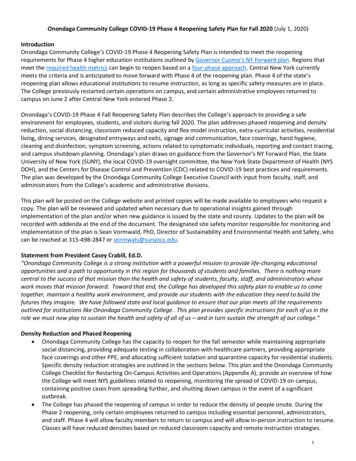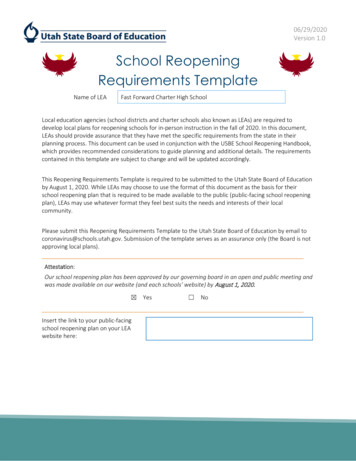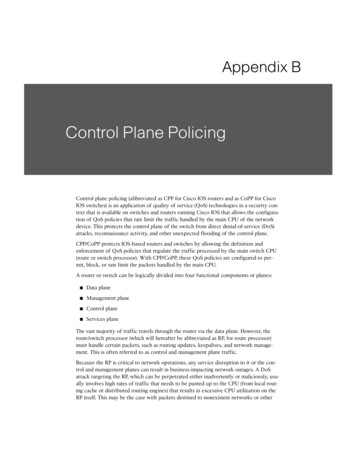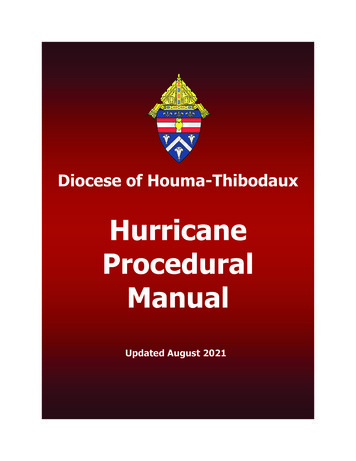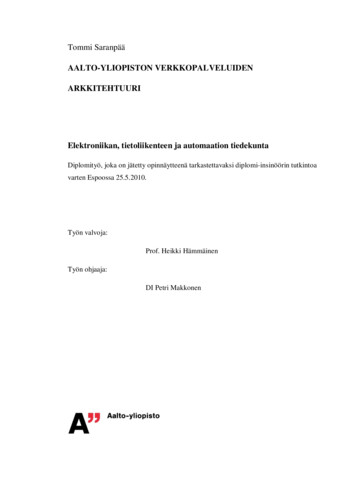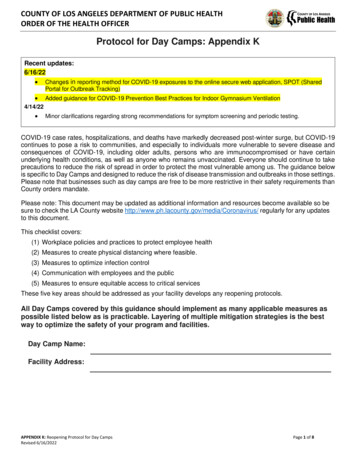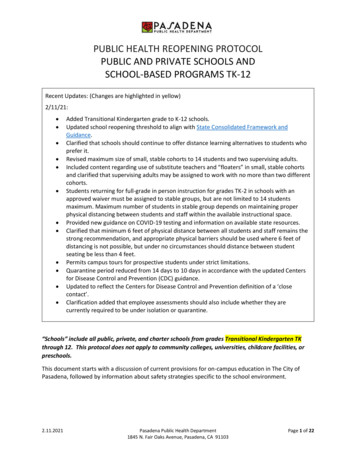
Transcription
PUBLIC HEALTH REOPENING PROTOCOLPUBLIC AND PRIVATE SCHOOLS ANDSCHOOL-BASED PROGRAMS TK-12Recent Updates: (Changes are highlighted in yellow)2/11/21:Added Transitional Kindergarten grade to K-12 schools.Updated school reopening threshold to align with State Consolidated Framework andGuidance.Clarified that schools should continue to offer distance learning alternatives to students whoprefer it.Revised maximum size of small, stable cohorts to 14 students and two supervising adults.Included content regarding use of substitute teachers and “floaters” in small, stable cohortsand clarified that supervising adults may be assigned to work with no more than two differentcohorts.Students returning for full-grade in person instruction for grades TK-2 in schools with anapproved waiver must be assigned to stable groups, but are not limited to 14 studentsmaximum. Maximum number of students in stable group depends on maintaining properphysical distancing between students and staff within the available instructional space.Provided new guidance on COVID-19 testing and information on available state resources.Clarified that minimum 6 feet of physical distance between all students and staff remains thestrong recommendation, and appropriate physical barriers should be used where 6 feet ofdistancing is not possible, but under no circumstances should distance between studentseating be less than 4 feet.Permits campus tours for prospective students under strict limitations.Quarantine period reduced from 14 days to 10 days in accordance with the updated Centersfor Disease Control and Prevention (CDC) guidance.Updated to reflect the Centers for Disease Control and Prevention definition of a ‘closecontact’.Clarification added that employee assessments should also include whether they arecurrently required to be under isolation or quarantine.“Schools” include all public, private, and charter schools from grades Transitional Kindergarten TKthrough 12. This protocol does not apply to community colleges, universities, childcare facilities, orpreschools.This document starts with a discussion of current provisions for on-campus education in The City ofPasadena, followed by information about safety strategies specific to the school environment.2.11.2021Pasadena Public Health Department1845 N. Fair Oaks Avenue, Pasadena, CA 91103Page 1 of 22
SPECIAL GUIDANCE FOR THE TK-12 SETTINGTK-12 schools in California counties that are in Tier 1 (Purple Widespread) of the State’s Blueprint for aSafer Economy, including the City of Pasadena, are prohibited from reopening for in-person instructionwhile the adjusted daily case rate remains above 25 per 100,000. During this period, when schools aregenerally restricted to remote learning, four types of on-site programming are permitted. In compliancewith this order and aside from these exceptions, TK-12 schools in the City of Pasadena may open onlyfor remote learning. During this period, employees and staff, as defined below, may report to schoolcampus for work in order to support essential operations, implement of remote learning or conduct onof the four permitted types of on-campus learning, listed below. Schools offering on campus learningopportunities should also continue to offer 100% distance learning opportunities to families that preferit.Day care for school-aged children and/or child care programs located in schoolsLocal Education Agencies (LEAs) and schools that offer day care services for children at schoolsmust be in compliance with the protocol for Programs Providing Child Care – Public HealthReopening Protocol. Programs that wish to provide day care for school-aged children at schoolsshould communicate with their Community Care Licensing Regional Office to inquire regardingthe availability of waivers for licensed child care facilities and license-exempt providers due toCOVID-19. For additional information see PIN 20-22-CCP.As in the case of specialized services, use of outdoor space is strongly recommended for learningas well as for meals, recreation and other activities in the course of the day.Specialized services for defined subgroups of children who need in person services and supports LEAs and schools are not required to provide specialized, in-person services, but those that doso may serve students with IEPs, students who are English Language learners, and students withneeds that cannot be met through a virtual instruction platform. These students may be servedas needed, provided that the overall number of students present on-site does not exceed 25%of total student body at any one time. An exception to this 25% rule is schools that havereceived a waiver to return students in grades TK – 2 for in person instruction. Schools that havereceived a waiver are permitted to bring all students in grades TK – 2 back to campus includinghigh need students in those grades. In that situation, the school may also bring up to 25% oftotal student enrollment in grades 3 and above at any one time for specialized support andservices for high need students in those grades, as long as the school can adhere to distancing,infection control, and cohorting requirements. Specialized services may include but are not limited to occupational therapy services, speechand language services, other medical services, behavioral services, educational support servicesas part of a targeted intervention strategy, or assessments, such as those related to EnglishLearner status, Individualized Education Plans and other required assessments. No child may be part of more than one cohort. Students who are part of a cohort may leave thecohort for receipt of additional services. Any additional services, however, must be providedone- on-one by the appropriate specialist in a secure space that is apart from all other people. Schools must agree to cooperate with the Pasadena Public Health Department with regard toscreening, monitoring and documentation that will be required to permit careful scrutiny ofhealth outcomes associated with this initial period of expansion. To the extent consistent with specialized needs of students in a given cohort, use of outdoorspace for at least 50% of the school day is strongly encouraged.2.11.2021Pasadena Public Health Department1845 N. Fair Oaks Avenue, Pasadena, CA 91103Page 2 of 22
LEAs and schools that choose to implement these on-site services for students with specializedneeds while schools are otherwise closed to in-person instruction, must inform the PasadenaPublic Health Department of their plans prior to start of services. A Document Submission for K12 Schools Offering Limited In-Person Services for Students with Special Needs is available onthe Pasadena Public Health Department website. If a school has already been approved for awaiver to reopen for students in grades TK – 2, the school still is required to file a notification toprovide services to students with special needs if the school intends to bring students back tocampus in addition to those in grades TK – 2.Further information from the State concerning specialized services may be found at SpecializedSupport and Services.Students may come on campus for supervised administration of college admission tests, includingPSAT, ACT, and SAT exams. College admission tests, including PSAT, ACT, and SAT exams, may be conducted at schools aslong as students are appropriately cohorted for the entire duration of the assessment (no morethan 14 students in each classroom with a distance of at least 6 feet between students andbetween students and teachers). All students and staff must wear face coverings for the entire time on campus, and all infectioncontrol protocols must be in place. Arrival and dismissal times are staggered between cohorts, and no gathering is permitted at anytime, including at arrival and dismissal times or during test breaks.On-site instruction of children in grades TK-2 by schools that have received a Public HealthDepartment waiver for in-person education. No school may bring students in grades TK-2 onto campus for general, in-classroom instructionuntil the adjusted case rate for the County has decreased to below 25 cases per 100,000population for 5 consecutive days, unless the school has previously been granted an elementaryschool waiver specifically permitting in-person instruction for grades TK-2. Students in grades TK-2 returning for general in-person instruction, must be assigned to stablegroups that maintain stable membership of students and instructors day to day and do not mixwith other stable groups. The size of these stable groups is not limited to a specific maximumnumber, but is dependent on utilization of the available classroom space to allow physicaldistancing of 6 feet between all students and staff. Schools must complete the State COVID-19 Safety Plan for In-Person Instruction, submit it to theCA Department of Public Health, and post it on the publicly-accessible school website. Then theschool must send the link to the posting on the school website to the Pasadena Public HealthDepartment.All measures to ensure the safety of employees and students in this protocol for Reopening of TK-12Schools and in the associated protocol for K-12 Exposure Management must be implemented and areapplicable to all on-site personnel, including those providing specialized services. The followingparagraphs highlight safety strategies specific to the school environment.COHORTINGFor three types of on-site programming that are permitted at all schools, cohorting with a maximum of14 children is required: day care for school-aged children, specialized services for defined subgroups ofchildren, and administration of college admission tests. Students must be organized and proceedthrough the day within the same small cohorts, defined as stable groups of no more than 14 children or2.11.2021Pasadena Public Health Department1845 N. Fair Oaks Avenue, Pasadena, CA 91103Page 3 of 22
youth and no more than two supervising adults in a supervised environment in which supervising adultsand children stay together for all activities (e.g., meals, recreation, etc.), and avoid contact with peopleoutside of their group in the setting. Note that if a cohort has fewer than 14 children or if a child stops attending a previously fullcohort other children who are not already assigned to a cohort can be added to the group toreach the maximum of 14, provided all the children, once assigned remain with the same cohortat all times. If some children are assigned to a stable cohort but only attend part-time, they must be countedas full members against the maximum of 14. Part-time members cannot “share” their slot withother part-time students. Other children cannot be added in order to reach the maximum of 14participants at all times. Aides assigned to individual children do not have to be counted as supervising adults. Theymust, however, be counted against the maximum of 16 individuals who can be included in acohort. Supervising adults may be assigned to work with two different cohorts if the two cohorts arepresent at school on different days of the week or different sessions during the day, for examplean AM and PM session. Assignment to more than two cohorts is not permitted. Deployment of substitute providers who are covering for short-term absences is allowed, butthey must work with no more than 2 cohorts of children per day. Essentially, the substitute willadopt the assignment of the absent employee for whom they are covering and work exclusivelywith the same cohort(s) to which the permanent employee is assigned. “Floaters,” who cover for supervising adults during the day for employee breaks, may constitutea third supervising adult in the cohort, but may not provide coverage for more than twodifferent cohorts during a day and should be spending limited time with any one cohort asneeded to provide coverage for the permanently assigned supervising adults. Importantadditional details for implementation of cohorts are available from the CA Department of PublicHealth Guidance Related to Cohorts. Important additional details for implementation of cohorts are available from the CADepartment of Public Health at Guidance for Small Cohorts.For on-site instruction of children in grades TK-2 where permitted, instruction must be provided instable groups, however the size of such groups are not limited to 14 students and 2 supervising adults.The size of the stable group must be set to allow for appropriate physical distancing between allstudents and staff at all times in the available instructional space.LIMITED ON-CAMPUS DENSITYWhile Local Education Agencies (LEAs) or schools may configure as many cohorts as are appropriate tomeet student needs for specialized services, the total on-campus population may not exceed 25% of thetotal student body at any one time for this particular purpose. The 25% limit does not apply to schoolage children on campus receiving day care while engaged in distance learning activities, nor does it applyto students in grades TK - 2 returning after granting of a school waiver. Schools that have been granted awaiver to return students in grades TK -2 may bring additional students onto campus for specializedservices in grades above grade 2, up to a maximum of 25% of student enrollment in grades 3 and above,as long as the school can adhere to distancing, infection control, and cohorting requirements.SUPERVISING ADULTSA supervising adult is an adult assigned to one cohort of children or youth, who does not physicallyinteract with any other cohorts. Supervising adults may be child care staff, certificated or classified2.11.2021Pasadena Public Health Department1845 N. Fair Oaks Avenue, Pasadena, CA 91103Page 4 of 22
school staff, volunteers, participating parents or caregivers, or other designated supervising adult(s). Anaide who is present to provide support to an individual child should be counted as a member of thecohort but not as a supervising adult. A supervising adult may be assigned to 2 different stable cohorts ifthey offer specialized services/support that cannot be provided by any other supervising adult.SUPERVISED ENVIRONMENTSA supervised care environment is an environment where multiple children or youth, from multiplefamilies or households, are supervised simultaneously by an adult. This includes, but is not limited to,licensed child care facilities, licensed exempt child care programs, supervised programs on a school sitewhile a school is not in session or is providing curriculum in a distance-learning format, or where someeducational services are being offered to a subgroup of students defined by a local educational agencyon a school.These protocols are provided for schools for use in the instance that community COVID-19 conditionswill permit return to in-person TK-12 education in the City of Pasadena for the 2020-21 school year.Public and private schools and school-based program should adopt contingency plans for remotelearning, if worsening community COVID-19 conditions (e.g., increasing cases) or emerging scienceindicates a need for greater caution. Schools should be in compliance with the California State HealthOfficer Orders and guidance, Pasadena Health Officer Orders and guidance, California Department ofEducation, and additional applicable public health guidance.This document may be updated as new information and resources become available. Go tohttps://www.cityofpasadena.net/covid-19/ for updates to this document.Steps to ReopenComplete and implement the Public Health Reopening Protocol Checklist and the ExposureManagement Plan.Follow additional protocols relevant to operations: aq-protocolsOffice Workspace – Public Health Reopening ProtocolRestaurants – Public Health Reopening ProtocolFitness Facilities – Public Health Reopening ProtocolPlaces of Worship – Public Health Reopening ProtocolPublic Pools – Public Health Reopening ProtocolYouth Sports – Public Health Reopening ProtocolPrograms Providing Child Care – Public Health Reopening ProtocolProvide a copy of the Public Health Reopening Protocol to each staff member and family andconduct education.Post a copy of Public Health Reopening Protocol in conspicuous locations visible to staff,parents, students, and visitors and post to your website.Ensure compliance with other oversight or regulatory agencies, such as the CaliforniaDepartment of Education and the California Department of Public Health. Regularly reviewupdated guidance from state agencies, including the California Department of Public Health andCalifornia Department of Education.2.11.2021Pasadena Public Health Department1845 N. Fair Oaks Avenue, Pasadena, CA 91103Page 5 of 22
Ensure your designated COVID-19 School Compliance Task Force and School Compliance Officerare trained and prepared to implement the Exposure Management Plan.Guiding Principles for Your School Community to Keep in MindThese protocols are provided for school administrators, faculty, staff, and parents to implementmeasures that may reduce the risk of disease transmission in the school setting, based on the currentscientific evidence available for COVID-19 virus.Any setting that brings people together poses a risk for disease transmission, so in choosing to movefrom the lowest risk setting to a higher risk setting, the school community is knowingly agreeing totake on that risk, and must be prepared to mitigate the impact of COVID-19 cases among their schoolcommunity members. The more people a student or staff member interacts with, and the longer thatinteraction, the higher the risk of COVID-19 spread. The risk of COVID-19 spread increases in schoolsettings as follows:Lowest Risk: Students and teachers engage in virtual-only classes, activities, and events.More Risk: Small, in-person classes, activities, and events. Groups of students stay together andwith the same teacher throughout/across school days and groups do not mix. Students remainat least 6 feet apart at all times, wear face coverings at all times, and do not share objects (e.g.,hybrid virtual and in-person class structures, or staggered/rotated scheduling to accommodatesmaller class sizes).Highest Risk: Full-sized, in-person classes, activities, and events. Students are not spaced apart,share classroom materials or supplies, and mix between classes and activities.Key PracticesResourcesCalifornia Department of Public Health – Reopening In-person Learning Framework K-12California Department of Public Health - Guidance for Small Cohorts/Groups of Children andYouthCenters for Disease Control and Prevention (CDC) – Schools Decision Tree to ReopeningCenters for Disease Control and Prevention (CDC) – Guidance for Schools and Childcare2.11.2021Pasadena Public Health Department1845 N. Fair Oaks Avenue, Pasadena, CA 91103Page 6 of 22
Additional resources, including a printable COVID-19 Business Toolkit SignageCalifornia Department of Education – Stronger Together: A Guidebook for the SafeReopening of California’s Public SchoolsCalifornia Department of Public Health – Vendor list to purchase personal protectiveequipment2.11.2021Pasadena Public Health Department1845 N. Fair Oaks Avenue, Pasadena, CA 91103Page 7 of 22
PUBLIC HEALTH REOPENING PROTOCOL CHECKLISTPUBLIC AND PRIVATE SCHOOLS ANDSCHOOL-BASED PROGRAMS TK-12REDUCING RISK OF COVID-19 TRANSMISSIONSchools and school-based programs must implement all applicable measures listed below and beprepared to explain why any measure that is not implemented is inapplicable to the campus. Designateone individual to be in charge of planning and implementation of all items. Submission of Protocol to aCity Department is not required unless explicitly requested.PERSON RESPONSIBLE FOR IMPLEMENTING PROTOCOLSSchool/Campus Name:St. Gregory A&M Hovsepian SchoolPerson in Charge:Shahe MankerianTitle:PrincipalPhone Number:Date:(626)578-13432/11/2021Mr. Shahe Mankerian, PrincipalI, ,(PRINT NAME and TITLE of person attesting that all protocols have been implemented)do attest that all public health protocols have been implemented atSt. Gregory A&M Hovsepian School(name of school)on this date,2/11/2021.(signature)2.11.2021Pasadena Public Health Department1845 N. Fair Oaks Avenue, Pasadena, CA 91103Page 8 of 22
The terms “employees” and “staff” are used in these protocols to refer to individuals who work in aschool facility in any capacity associated with teaching, coaching, student support, provision of therapiesor personal assistance to individual students, facility cleaning or maintenance, administration, or anyother activity required for the school to function. “Employees” or “staff” may include individuals who are:paid directly by the school system, paid by entities acting as contractors to the school, paid by outsideentities acting in collaboration with the school to serve students, paid by third parties to provideindividual student services, or unpaid volunteers acting under school direction to carry out essentialfunctions. The term “parents” is used in these protocols to refer to any persons serving as caregivers orguardians to students.If you have questions, or if you observe a violation, you can request information or submit a complaintthrough the Citizen Service Center. Call 626-744-7311 or visit https://www.cityofpasadena.net/CSC.PROTECTION OF STUDENTS, VISITORS AND STAFF FROM COVID-19 Connect staff and families to resources to access health insurance, a primary care doctor, andCOVID-19 testing prior to reopening, such as calling 211 or 626-744-6068 for information onhealth insurance and primary care physicians, or th/.Implement the COVID-19 Exposure Management Plan to limit the spread of COVID-19 amongstudents and staff. The plan must designate a COVID-19 School Compliance Task Forceresponsible for establishing and enforcing all COVID-19 safety protocols and ensuring that staffand students receive education about COVID-19. Designate one member of the team as theSchool Compliance Officer, who acts as the liaison to the Pasadena Public Health Department inthe event of an outbreak on campus. The plan identifies steps that will be taken immediatelyupon notification of school officials that any member of the school community (faculty, staff,student or visitor) tests positive for, or has symptoms consistent with COVID-19, including butnot limited to:Sending staff home immediately if they arrive sick or become sick during the day,ensuring physical distancing, that they are wearing a face covering (provide with asurgical mask if possible), and privacy is maintained. Encourage sick staff to contacttheir medical provider. If the illness is work-related, the employer should facilitateappropriate care for the staff member, the worker’s compensation process, leave time,and California Occupational Safety and Health Administration (OSHA) record keeping.For anyone who is waiting to be picked up from school due to symptoms of COVID-19,or coming into close contact with someone with COVID-19, place that person in anisolation room with monitoring, preferably in an area where others do not enter or pass.Provide divided spaces for those who are asymptomatic, separated from those who aresymptomatic. Make sure that the person keeps a face covering on (provide with asurgical mask if possible). When a parent/guardian arrives to pick up a student, have thestudent walk outside, supervised, to meet them, if possible, instead of allowing theparent or guardian into the building since the parent may also have COVID-19.Providing fact sheets/information, in an appropriate language, on maintaining isolationand quarantine in accordance with Health Officer Orders and CDC guidance.2.11.2021Pasadena Public Health Department1845 N. Fair Oaks Avenue, Pasadena, CA 91103Page 9 of 22
Making an immediate report to the Pasadena Public Health Department any time astudent or staff member with COVID-19 (confirmed by a lab test or physician diagnosis)was at the campus while sick or up to 2 days before showing symptoms. The COVID-19Compliance Officer must call (626) 744-6089 or email nursing@cityofpasadena.net andprovide all information requested by the Health Department. The IHE is expected toprovide or ensure testing for all staff that have had a possible exposure and must followthe US Centers for Disease Control and Prevention (CDC) guidance for cleaning anddisinfecting the campus. Testing resources can be found by calling the individual’sphysician, and also at https://www.cityofpasadena.net/covid-19/ andhttps://covid19.lacounty.gov/.Working with the Pasadena Public Health Department to investigate any COVID-19illness. The COVID-19 School Compliance Task Force should designate trained staff tocompile student and personnel records, campus floor plans, and staffing/studentattendance logs to provide information as quickly as possible to the Health Department,including accurate contact information (phone, address, email) of all staff, students, andvisitors and who had close contact (within 6 feet of the infectious person for 15 minutesor more). The COVID-19 School Compliance Officer should submit the completed COVID-19 Exposure Investigation Worksheet to PPHD.Schools must enroll staff in the free, state-provided contact tracing training course priorto reopening.Implementing communication plans for exposure at school and potential school closuresto include outreach to students, parents, teachers, staff and the community.Providing guidance to parents, teachers and staff reminding them of the importance ofcommunity physical distancing measures while a school is closed, including discouragingstudents or staff from gathering elsewhere outside of school.Maintaining regular communications with the Pasadena Public Health Department. Develop and implement a flu vaccination program (vaccine education, promotion, anddocumentation of completed, current vaccination) with the goal of influenza immunization forall students and staff unless contraindicated by documented medical exemption for flu vaccine,prior to or at the beginning of the flu season (typically starts November 1) to help:Protect the school community from influenza, and co-infection with influenza andCOVID-19 virusesReduce demands on health care facilitiesDecrease illnesses that cannot be readily distinguished from COVID-19 and wouldtherefore trigger extensive measures from the school and public health authorities.Develop a plan for continuity of education. Current levels of community transmission meanschools should expect frequent cases of COVID-19 in the school setting. Because each case willtrigger mandatory 10-day home quarantine for every close contact even if face coverings areworn, in-person classes will be disrupted. No test result will shorten the 10-day quarantine whenstaff or students cannot return to campus. The plan should delineate how nutrition and otherservices provided in the regular school setting will continue.2.11.2021Pasadena Public Health Department1845 N. Fair Oaks Avenue, Pasadena, CA 91103Page 10 of 22
Health Screening Conduct daily symptom checks for all persons entering the building or campus before or upon arrival (fever of 100ºF or above, cough, shortness of breath or difficulty breathing, fatigue, sorethroat, chills, headache, muscle or body aches, a new loss of taste or smell, congestion or runnynose, nausea, vomiting, or diarrhea). Consult the CDC website for the most current list ofCOVID-19 symptoms. These checks can be done remotely or in person upon arrival. Thescreening must include asking if the person (adults and middle and high school-age students,and for younger students, ask the parent) has had contact with a person known to be infectedCOVID-19 in the last 14 days, and whether the individual is currently under isolation orquarantine orders. Quarantine (send home) everyone who came into close contact (within 6feet for 15 minutes or more over a 24-hour period, regardless of whether a mask was worn)with someone with confirmed COVID-19 within the past 14 days. They must maintainquarantine at home for 10 days, regardless of any interim test results.These screenings can be done in-person upon arrival at the site or remotely before arrival usinga digital app or other verifiable approach.o A temperature check with a no-touch thermometer at entry is recommended as part ofthe screening, especially for visitors who may not be part of a systematic at-homescreening process.Notify the COVID-19 School Compliance Task Force of any positive screening result and initiatethe COVID-19 Exposure Management Plan.Require any sick staff or student to stay home for at least 10 days or until 24 hours after feverand symptoms resolve (without use of fever-reducing medications), whichever is longer.A case is considered to be infectious from 2 days before their symptoms first appeared until thetime they are no longer required to be isolated (i.e., no fever for at least 24 hours, without theuse of medicine that reduces fevers AND other symptoms have improved AND at least 10 dayshave passed since symptoms first appeared).Review and modify workplace leave policies to ensure that staff are not penalized when theystay home due to illness.Students who screen positive are given a surgical mask and accompanied to a pre-selectedisolation space where they can remain while a determination is made on exclusion andarrangements are made for their return home, where indicated.Reduced Contact Adopt a cohorting approach school-wide, maintaining a stable group of no more than 14 children or youth and no more than two supervising adults in a supervised environment in whichsupervising adults and children stay together for all activities (e.g., meals, recreation, etc.), andavoid contact with people outside of their group in the setting, throughout the school day. (Asuperv
2.11.2021 Pasadena Public Health Department Page 1 of 22 1845 N. Fair Oaks Avenue, Pasadena, CA 91103 PUBLIC HEALTH REOPENING PROTOCOL PUBLIC AND PRIVATE SCHOOLS AND SCHOOL-BASED PROGRAMS TK-12 Recent Updates: (Changes are highlighted in yellow) 2/11/21: x Added Transitional Kindergarten grade to K-12 schools.
